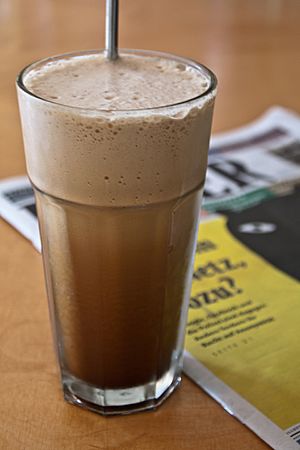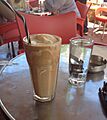Frappé coffee facts for kids

Classic frappé with no milk
|
|
| Type | Iced coffee |
|---|---|
| Place of origin | Greece |
| Created by | Dimitris Vakondios |
| Main ingredients | instant coffee, sugar, milk, water |
A frappé coffee is a popular Greek iced coffee drink. People often just call it a frappé. It is made from instant coffee, water, sugar, and milk. The word "frappé" comes from French and means "chilled with ice."
The frappé was invented by accident in 1957 in Thessaloniki, Greece. It quickly became one of the most popular coffee drinks in Greece and Cyprus. It is now a famous part of Greek coffee culture.
Contents
The History of Frappé Coffee
The name frappé comes from a French word. It describes drinks that are made cold with ice. In the 1800s, there were already cold coffee drinks called café frappé. Some were like slushes, and others were more like iced coffee.
How the Greek Frappé Was Invented
The Greek frappé, which uses instant coffee, was created in 1957. This happened at the Thessaloniki International Fair. A company called Nestlé was showing a new chocolate drink for kids. You mixed it with milk and shook it in a cocktail shaker.
Dimitris Vakondios worked for Nestlé. During his break, he wanted his usual instant coffee. But he could not find any hot water. So, he tried mixing his coffee with cold water and ice cubes in the shaker.
This quick experiment created the first frappé! It became popular very fast in Greece. Nestlé then helped make the drink even more famous in the 1980s. Because of this, the name Nescafé became strongly linked to the frappé. Today, people in Greece usually just say "frappé."
How to Make a Frappé
You can make a frappé using a cocktail shaker. Today, many people use an electric milk frother or a milkshake machine.
Step-by-Step Frappé Making
First, you take instant coffee. Traditionally, people use Nescafé. You can also add sugar if you like. Then, you add a little water. You shake or blend these ingredients together. You keep going until you get a thick, foamy top.
Next, you pour this foamy mix into a glass. Then, you add ice cubes and cold water. If you want, you can also add milk. Many people use evaporated milk. Frappés are almost always served with a drinking straw. This is because the thick foam on top can taste a bit bitter to some people.
The Special Frothy Top
The spray-dried instant coffee used for frappés has almost no oil. This is why the frappé can form its famous thick layer of foam.
Why the Foam Lasts Long
Frappé foam is like the crema you see on an espresso. But it is thicker and lasts much longer. This is because it has very little oil. The foam is a mix of air bubbles, tiny coffee bits, and water.
Depending on the size of the bubbles and how much sugar is in the frappé, the water slowly drains from the foam. This can take anywhere from 2 to 10 minutes. As the water drains, the foam gets thicker. It can even become almost solid before it slowly disappears.
If you use freshly brewed coffee or freeze-dried instant coffee, you won't get a long-lasting foam. These types of coffee have more oils. Even how you make the frappé can change the bubbles. For example, using a handheld shaker can make smaller, more stable bubbles that last longer.
Frappé Names and Different Kinds
In Greece, when you order a frappé, you usually say how sweet you want it. You also say if you want milk.
Sweetness Levels
For two spoonfuls of instant coffee, here are the common sweetness levels:
- glykós (γλυκός) means 'sweet' – this uses 4 spoonfuls of sugar.
- métrios (μέτριος) means 'medium' – this uses 2 spoonfuls of sugar.
- skétos (σκέτος) means 'plain' – this has no sugar.
Adding Milk
Milk, usually evaporated milk, is not added unless you ask for it. You say me gála (με γάλα) which means 'with milk'. If you don't want milk, you can say horís gála (χωρίς γάλα), meaning 'without milk'.
Sometimes, a frappé with milk is called frapógalo (φραπόγαλο), which means 'frappé-milk'. In some places, especially in Cyprus, frappés are made with milk instead of water.
Other Fun Variations
At some places, like beach bars, people might add a little bit of liqueur to frappés. Other restaurants might add a scoop of vanilla ice cream instead of milk.
Some frappé variations are not shaken. They are stirred with a spoon if a shaker isn't available. These have a different texture and taste. They are often called koutalátos (κουταλάτος), meaning 'spoon-made'. They can also be called karavísios (καραβίσιος), meaning 'of the ship', because sailors used to make them this way at sea.
Freddo Espresso and Freddo Cappuccino
There are also other popular Greek iced coffees:
- The freddo espresso is a Greek iced espresso. It first appeared in Athens in 1991 and has become very popular. Some people see it as a "higher quality frappé."
- The freddo cappuccino is a freddo espresso with a cold milk foam on top. This foam is called afrógala (Greek: αφρόγαλα).
Frappé Around the World
Frappés are strongly linked to Greece. But in recent years, they have become popular in other countries too.
How Frappés Spread Globally
Frappés became more widely known outside Greece after the 2004 Summer Olympics in Athens. Many tourists tried them and loved them. An article about frappés was even published in the Los Angeles Times. Greek people who moved to other countries and tourists visiting Greece also helped spread the drink.
Today, you can find different kinds of frappés in many places:
- In Bulgaria, sometimes Coca-Cola is used instead of water.
- In Denmark, milk is used instead of water.
- In Serbia, frappés are made with ice cream and whipped cream on top. They are also called "cold instant coffee" there.
- Other Balkan countries like Albania have similar versions. The Albanian version often uses water or a mix of milk and water, and a more bitter coffee.
Images for kids
See also
 In Spanish: Café frappé para niños
In Spanish: Café frappé para niños



